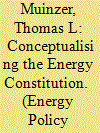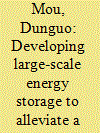| Srl | Item |
| 1 |
ID:
176746


|
|
|
|
|
| Summary/Abstract |
In order to elucidate key aspects of the relationship between energy and constitutionality, Muinzer and Ellis (2017) have mapped the full spectrum of UK reserved/devolved constitutional powers and thrown into relief the complex form and nature of low carbon energy powers within that nexus. This low carbon-specific framework, and an understanding of its complex, contingent qualities and interconnected constitutional principles provides insight into the extent to which constitutional arrangements reify the territoriality of energy governance and policy capacity, structuring the policy and governance relationships between national and substate multi-level decarbonisation processes. This study develops this ‘Energy Constitution’ framework with reference to fuel poverty, honing in on the UK and according particular attention to Northern Ireland, a UK jurisdiction that often receives little attention in energy policy studies, but that has had notably high levels of fuel poverty, in addition to the weakest substate economy and the most energy insecure circumstances in the UK.
|
|
|
|
|
|
|
|
|
|
|
|
|
|
|
|
| 2 |
ID:
166934


|
|
|
|
|
| Summary/Abstract |
By taking the grid system in Fujian Province as an example, this paper establishes a power market system model to simulate the impact of nuclear and wind power on the system operation. The article employs the method of optimal power flow (OPF) analysis, under a framework of social welfare maximization with close-to-reality thermal power generation cost and technical constraints. The simulation results show that large-scale nuclear power can reduce the level of electricity prices and improve the difference in regional electricity prices; as a result, the thermal power can be in an unfavourable position and therefore undertake peak and load following; meanwhile, the development of large-scale wind power would increase the demand for following of load and valley load. Moreover, the simulation for the operation of the electricity market shows that in the case of electricity oversupply, the thermal power can be deliberately bid at a low price, and the nuclear power would assume the obligation of valley load following, even with the presence of PSHPs in the system; thus, the low-carbon energy can't be fully utilized. In conclusion, the general bidding model in the electricity market cannot be applied to the situation of long-term electricity oversupply.
|
|
|
|
|
|
|
|
|
|
|
|
|
|
|
|